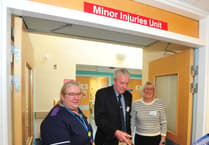HEALTH trust officials say they are doing all they can to minimise the impact caused by crumbling buildings at Torbay Hospital.
Sewage and water leaks have been reported in the ageing hospital buildings which are due to be replaced by 2030.
The hospital has been in the spotlight after a critical report by the Torbay and South Devon NHS Trust, which runs it.
The document revealed leaks in some of the hospital’s older sections, and said the trust is spending a million pounds a year on scaffolding and remedial works.
Torbay is the third-oldest hospital in the country and large areas of its main block date back nearly 60 years.
The report said the poor state of the buildings is impacting patients, causing health and safety issues and affecting staff morale and recruitment.
It prompted calls for the health secretary to step in and make sure promised funds are delivered quickly.
Adel Jones, deputy chief executive of the trust and director of transformation and partnerships, said: ‘Parts of our estate at Torbay Hospital are some of the oldest in the country.
‘Due to the age and condition of our estate we have robust mitigation and management plans in place to minimise the impact on patient care and patient and staff experience.
‘However, the issues remain a recurrent risk until we have our new hospital.
‘We are proud to be part of the New Hospitals Programme which is a once-in-a-lifetime opportunity providing us with funding to significantly redevelop and rebuild large areas of Torbay Hospital.
‘We are in cohort four of the programme and the timeline we have been given is that our new buildings will be complete by 2030.’
Ms Jones said while the trust was planning for the new hospital, it was also making improvements to its current facilities.
She went on: ‘In the past 18 months we have opened our new £15 million acute medical unit, a £2.8 million radiotherapy unit, a £4.99million endoscopy suite and two new £15 million theatres for eye surgery and day surgery.
‘These new facilities are helping us to reduce waiting times and improve patient care, experience and outcomes.’




